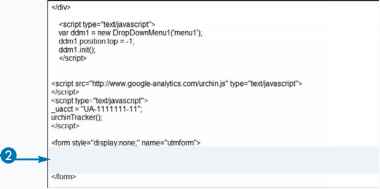Extra Vzu
After e-commerce tracking is successfully installed, allow time to pass so that there is enough meaningful data collected to allow you to make accurate decisions. Depending on your sales volume, a month or less should be a sufficient time frame to collect meaningful data. View the E-commerce report for your Web site profile. In the bottom-right corner, your sales sources are listed. Click any of these links that are search engines. For example, use Google Organic. Clicking Google Organic opens the list of your top keywords for the month. Click the Revenue column to sort your keywords by the amount of revenue each accounted for. You now have a list of your most valuable keywords.
Next, visit www.google.com and start searching for your top keywords from that list you just viewed. Where is your site ranking for those keywords? If the answer is not position 1, you have found some potential targets for search-engine optimization, and possibly even for pay-per-click. Targeting your top keywords and making sure you are ranked as highly as possible for them ensures that you make the most revenue from your search-engine efforts.
Insert Tracking Code on Your Thank You Page


You can track your e-commerce transactions by inserting the tracking code on your Thank You or receipt page. This is the page the customer sees after his order has been processed, and typically has a recap of what products were purchased, their price, and the total amount. By placing the tracking code on this page, Google Analytics can catch all these variables and bring them into your Web site analytics reports. From there, you can incorporate this sales data into your reports on traffic sources and content, as well as visitor information. As was mentioned in the first task of ecommerce tracking ("Set Up E-Commerce Tracking"), having the sales information attached to your visitors and the way they reached your site can prove invaluable. Be cautious about who you show your e-commerce data to. Your top keywords should be kept extremely confidential. The last thing you want to do is tip your competition off on some profitable keywords they may have overlooked.
The variables that are included in the code you place on your receipt page will vary depending on the shopping cart software that you use. If your Webmaster is unsure of the actual variables, check the documentation of your shopping cart software. Alternatively, if you have a shopping cart that is hosted by a third party, contact the company that hosts your cart and ask the company to identify each of the variables for you. Identifying these variables and implementing them into your tracking code are the most complicated steps of the process because there is no simple, standard solution.
Insert Tracking Code on Your Thank You Page
1 Ensure that the regular Google Analytics tracking code is correctly installed on your Thank You or receipt page.
<ahref "http:/,fwww.pepperjam.comfsearcli/'"att "Peppenam Search" title "Pepperfam Search">SLARCIk/a- <b>&mddot*rt)> -a href="http://www.pepperjam com/affiliate/' alt= title-'Peppci jam Affilate">AFFIUATE</a> &nbtjp,<b>&iT5iddol,«/b>&rib«jpp <a li[cf="Wlp.//www-peppcHjua Media" title "PepperjamMedia">MtUlA</a> <b=*·'^> :^ hret "httpiiVwww.peppe alt-'Pepperjam Technology" litte="Pepper}am Tectinology"^TCCMNOLOGY^/a- <b^&middol;</fc tiref="http //Www.pepperjam com/clienUi st.php" alt-'Portfolio" tide-' Portfolio^ PORTFOLIO </a > c hret-"http7/www pcpporjiim r.om/aboijt-peppof]am php" titlfi-Mikimpany" alt-"ikimpariy">{)()MPANY</.Ta href="httpi/www.pepperjamblog.com" alt="Dlog" title=MBlog">BLQG</a> <hr color="#999999">
Acopy, 1999 - ?007 - Piipfrcijarn All Rights Reserved <bi> </div>
<script type-text/]avascript">
var ddmil - now nropDownMenul^mcniJl');
ddml.initQ;
script si[—'"http //www qoiM]h]-arialv1itJi carrtfurchin js;" tYp(i="lcixt/javas<:ripr> </scnpt>
«script type="textijavascripf > uacct = "UA-1111111-11"; urchin Frackcr(); -i/scripl>
Below the regular tracking code, paste the portion of code that catches the variables from your shopping cart.
You must replace the placeholders inside the brackets with the actual variables for whichever shopping cart your site is using. Do not include the brackets in your final code.

Edit the body tag of the receipt page to include the utmSetTrans function:
<body onLoad=Mjavascript:_
utmSetTrans()">
File Edit Format View Help
<fink rel-'stylesheet" type-lext/css" href="http://www.pepperjam.com/css/pjcss.css" /> <l-[if ItIF 7]>
<link reh"stykK¡heeí" lype_"texl/cssi" lirer-"hUp7/www.ptípperjaiiLcoiiVtss/ie pjcss.œs" t> <![endif]-><link rel-"stytesheer type-"text/css" href-''h^://vvvw.pepperjam.coiTVcss/dropdown.css'7>
<scjiprtype="rexti]avasmpt" src-'hîtpjVwww pepperjam nom/ie5 js"></srjipt> <scr¡pt typc="tcxt]avaGcript" Grc="hîtp://www.pcppcrjam.com/DropDownMcnu1 .j5"></Gcr¡pt> <scr i pl lang uay e~" JavaSu i pt" a c~"htlp .//www.pepperjai i isear üi. loi i i/foi.js' WüLi ipl> <-scn pt language-" JavaScri pr src-"http ://www.peppertracker. conVtrack/ptrack. |s"></scnpt> <seript language-'JavaScript" src=''http://vvww.pepperiamsearch.com/lib/actíon.js''></script>
-'body onLoad-ïavascript: <div id="container">
utmSetlransO"5-
4 If you cannot edit the body tag, the utmSetTrans function can be called separately by inserting a piece of JavaScript:
<script type="text/javascript">
_utmSetTrans();
<script typc="tcxt/javascnpt">
var ddm1 new DropDownMenul ('menul1);
ddm1.position.top =-1;
< script src-'httpjTwww googlfi-annlytirs mm/urchin js" typfi="text/javflscript"> </Gcript>
<scri pt type "text/javascri pt"> uacct= "UA-1111111-11"; urrhinTracker(); </Gcript>
<torm style="display:none;" name="utmtorm"> <textarea id="i Jtmtra ns"> I JTMTl[order-id]|[affi liati on]|
[totaOI[tax]| [Ghi ppi ng]| [city]|[stato]|[countfy] UTM:l[[orcicr-i d]|[skui,codc]|[produanamG]|[catcgory]|[pricc]|
[quantity] <rtextarea>
<Gcript typc="tcxt/javaGcript">
-_utmSetTransf);
Apply It
Here are the variables that you must edit, along with a brief explanation. Transaction Line Variables
[shipping] [city]
[state/region] [country]
Item Line Variables
[order-id]
[sku/code]
[product name]
[category]
[price]
[quantity]
Order ID number
Store affiliation optional
Total amount
Tax amount
The shipping cost
City
State/Province Country
Order ID number same as transaction line
The product's SKU code
Name of the product
Product category
Price of the product per unit
Quantity of the product ordered

Smaller e-commerce sites often use third-party solutions for shopping carts. Third-party shopping carts allow e-commerce merchants to accept credit cards as a payment option and have the added benefit of being hosted by a third party. It can be a lot easier during the initial setup, but when you want to track third-party shopping cart transactions with Google Analytics, you must take some extra steps. If you host your own shopping cart, you can skip this task because it does not apply to you. However, if you use any sort of remotely hosted or third-party shopping cart service, this task will prove useful.
The basic idea behind tracking while using third-party shopping carts is to get the information about the sale transferred from the remote cart back to your Web site, which may not seem like a problem at first because you
Using Third-Party Shopping Carts can include your tracking code on the remote page. However, you want to know the original source of those customers. Because of this, you must pass some information about your customer along to the secure site that hosts your cart.
This transfer of information is done by making additions to the links from your Web site to the third-party shopping cart. These pieces of code pass along all the information that Google Analytics has collected, including initial referral, time on site, and the path the customer took through your site while making his purchase. These are all infinitely valuable pieces of information that you definitely do not want lost in the transition to the remote shopping cart. Correctly installing these tags is of the utmost importance to tracking every one of your sales, and putting that knowledge to good use.
1 If you use a third-party shopping cart that is on a different domain than your Web site, adjust your Google Analytics tracking code to fit the format shown here. Note that you need to insert your actual Google Analytics user ID:
com/urchin.js" type=
"text/javascript">
<script>
_uacct="UA-xxxx-x" _udn="mystore.com"; urchinTracker(); </script>
2 Edit the links from your domain to the shopping cart domain to fit the following format:
<a href=" https://www. securecart.com/?store= parameters" onclick="
_utmLinker(this.href);
return false;">Purchase Now</a>
1 tinBfcpH Holrpjrf-
lundiun QpfiflWin(liteJRL1ifflnNflmairefltui6S) { wirKj< iw <]f]Hri(1lKiL II il ivi i iMnnw? IhhIi jths )
clink rel-"styfcsheeT type-'toxtfcss" href-"http:/f\vww.peppef)airi.corrVcss/pjcss.cs5" /> <KrflIIE 7]>
«lirik rel-"dylestieel" lype=lexUc3s" htef="l1Llp./ltvww.p^^ti^^^lxorl^s/le-pJcss.csij,, l> «llendil]-* iel="5tylesfje«r type-'lextfcss" htel-"htlpiiWww. peppeijam.cwiVcäs/droptJawn.cys" I*
-"■snipt lyfHi-"l«xl/|avaHCJip!" srt~"http ftwvm pHfifjerjam tturrtfieii pi'-'Wscripl:* <scripl type-'textliava script" src-Mhttp,'Avww pepperjam com'DrapDownMerYUI prescript--^script language-". Java Script" srr.-"http /hvww pepperjamsearch convfrn js"><j'script> ^script language-".Java Script" src-"hfttp .'Vwww peppertrarJcer cnnvtrack/ptrack p"></script> <scr ip( language-'JavaScript" src-"http:ffwww.peppcr^mscarch.corrVlib/acti on. js'Wscnpt>
: su ipt src="hUp./iwww.gtJogie-ana tytics. cun^tü chiri.js" lype-"texl/javasci ipt" > «/script*
<suipl type-'lexl/javasciipt"* tiacef-"LJA xm x" nrfn-'nnne" ufr*=1; jrchinTrackerO; </script>|
-IhjnWyiiu Noirjud
File Edit format View Help
<pabgn="righr>
Locatti<J at. it« Iririovaliuii Center { South Main Stieet, Fkwt 3<bt:> Wiltfts-HairH I'tHinsyh/HniH 18/t)t<br> <b>TekJb> 1 R77 796 5700 <br> <b>Fa*<ib> 570 400 9063 <itSv>
<img src-Titlp .'Vwww pepperjam rarTVimage£',!ulverhead jpg" width-"77B" height-" 150" styte-"position absolute- top 107px left 11px-/'>
<div id-"dropdownmenu V
stable cellspacing-IT cellpadding-"0" id-"menu1" class-"ddm1"> <tr>
<l<j><ftfiy si c="htl|}j,Mww.pepp(fijarfi.ctiiiViniageSildi opdowntell.jpg" widl)i="13" ti«jght="32" /»«fld» <ld>
<aclas5="ileiii1 search"
hrei-"rittp i'jWww pepperjam com/searcfir></a>
<div class-"section">
<a href=" Ntp5:/i"www.sccurccart.com,?storc=paramctcrs" oriclick=" utmUnkcrfthts.href); return falsefs-Purchase Now-^aH
3 If you use forms to submit the data to the third-party shopping cart, use the form shown in the example. This passes the information along correctly to the shopping cart domain:
<form action= "http://newdomain. com/form.cgi" onSubmit=" javascript:
_utmLinkPost
4 Ensure that any calls to utmTracker or utmSetTrans are above any of the links to the third-party shopping cart.
thanliyau Nnrrfud
"île Edit Format View Help
t oeaied at The Innovation Cenler<tx> 7 Sotdh Main Street, Floor 3<br> Wilkes Fïane Pennsyfcania 1fl701<br> <h>Tel<rt>> 1 R77 796 5700 <br> <b>raxc/b> 570-408-9863 </div>
tirngsic=,7ittp./i,wvvw.pepperjaiTi.coriv'(riiageti/ailveftiead.jpij" widtli="//8"tieigfrt="1ti<J"3tyle=,,poaititHi. absolute, lop 10/pi, left, tips <div rd="dropdownmeniT>
« table cellspaang="0" cellpaddirig-"O" id="rrtenu1" class-'ddHiV* <tr>
<tdximg SFC-"http:.li'www,popperjarri.cortVirnagesildropdownlcftjpg" width-" 13" hcighl-"32" txftd> <td>
<a class-"item1 search" hrof-"http:j'/www.pcpper)am.corn/search/"></a> <div dass-,,9ftCH«f>
<a href-" httpK /,'www securecart coiTV^store-parameters" onclick-" utml inker(this href); return false:">Purrhase Now/a> lotrn adion="hl1pJ/newdomai n. to riVI a t m. cgi oriikibrnit-"javasaipt_ulmLinkl 'osHthis)"»
thanlcyau Nntrfud
"il« Edit Format Vim ! I«lp script sif-"http/lfwww cjooqle analytics conVirchin ¡s" type-"textjfavascnpt"> ■</scripl>
'.script type-'texti^avascripfs iiaccl-"tJA xm x" _udn="none"; _ulmk=1. uidiinfratkerO, :/scnpt>
<div id-"container">
<a href-'Mp ,'?www pepperjam corru"all-"Pepperjam I tome" iitle-~Pepperjam I lome" border-TV*:-
<irng sic="liUp.//wvw.pepperjam.corlVl^llageii/pJlogaJpg,,wldlll=',200,, height-W 5lyte="lKMder.0px, position, absolute, top. 2px, lett. 33px,">«/a>
Continue reading here: An Introduction to Social Media Optimization
Was this article helpful?


